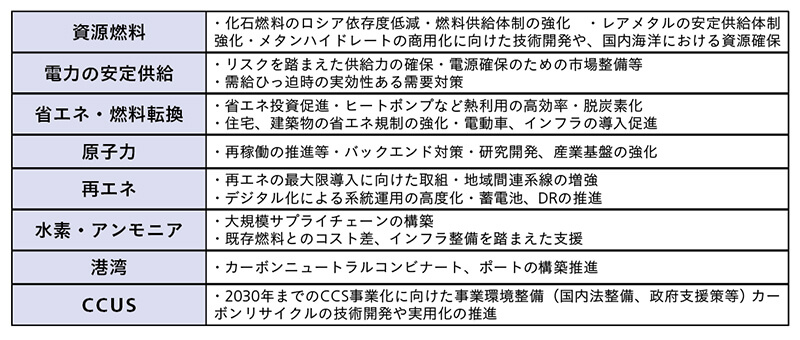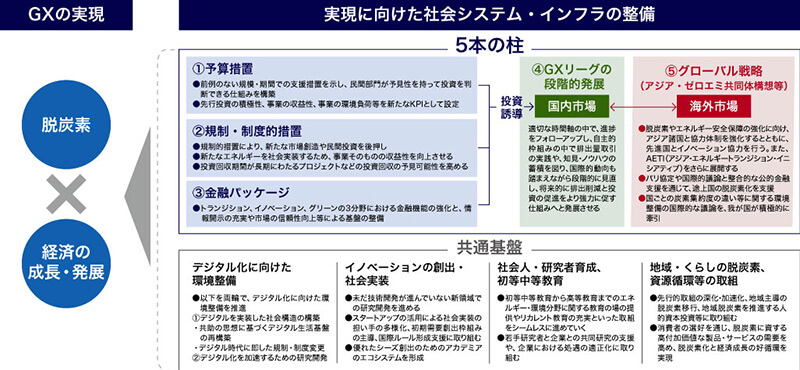Clean Energy Strategy] What is the strategy for linking global warming countermeasures to economic growth?

The Clean Energy Strategy is a growth strategy for achieving carbon neutrality by 2050, and it also embodies the 6th Strategic Energy Plan decided last year. Recently, the council's interim report on this strategy was announced, revealing its policy. Uncover the contents of the interim summary.
What is Clean Energy Strategy?
The Clean Energy Strategy includes specific measures for each industry with high growth potential, demand-side energy transition, transition to clean energy-centered economic, social, and industrial structures, and policies for decarbonization of regions and lifestyles. Includes responses, etc. Looking at the interim summary, the content also emphasizes ensuring energy security.
Chapter 1
Ensuring energy security
Chapter 1 presents the response and future direction based on the Ukraine crisis and the tight supply and demand of electricity. “Japan must overcome the transition of reducing its dependence on Russia and the transition of decarbonization. It is necessary to take all possible measures, and then decarbonize.” Based on this perspective, specific measures for each sector, such as resource fuels and electric power, are organized (Table 1).
Future Direction of Energy Policy (Table 1)
Chapter 2
toward a carbon-neutral society
Economy/Society, Industrial Structural Reform
In Chapter 2, in order to realize the growth and development of the Japanese economy at the same time as decarbonization, it is important not only to transform the current energy supply and demand structure, but also to drastically transform the industrial structure. Assuming that there is, the countermeasures for that are explained in the following four sections.
Section 1
Industry GX starting from energy
Towards carbon neutrality in 2050, we will consider the supply-demand balance of decarbonization measures and the competitive relationship based on the domestic and overseas business environment (domestic infrastructure restrictions, capital investment, domestic and foreign regulations, etc.) and the market size of each industry in Japan and overseas.・It is important to identify changes in complementary relationships. In order to survive the international megacompetition in the clean energy field, we will secure the predictability of investment in fields where growth is expected and attract large-scale investment (Table 2).
* GX (Green Transformation) is the transformation of the entire economic and social system in order to achieve carbon neutrality compatible with economic growth (editorial department note).
Fields with expected growth and direction of GX (Table 2)

Section 2
Transformation of industrial energy supply and demand structure
Pursuing thorough energy conservation and shifting to CO2-free energy consumption is a common way of thinking across industries. On the other hand, there is no single technology option or road to carbon neutrality, and it differs depending on the energy consumption and equipment status of companies. It is necessary to draw an appropriate transition based on the environment in which the company is placed, such as the technology available to each company and its position in the supply chain.
The government implements policies that combine appropriate methods based on the necessity and urgency of promoting corporate behavior, the high business risk due to the size of investment, etc., and the appropriateness of support and regulations. In particular, regarding fund procurement, appropriate support measures will be implemented according to the transition pattern of each company and industry.
SMEs, etc., which support about 70% of employment in Japan, account for 10% to slightly less than 20% (120 million tons to 250 million tons) of greenhouse gas emissions in Japan as a whole. is also essential. Efforts by small and medium-sized enterprises to become carbon neutral can also lead to stronger management in terms of cost reduction through energy conservation, the acquisition of financing methods, and the improvement of the competitiveness of products and companies.
For small and medium-sized enterprises, we will support measures such as visualization of greenhouse gas emissions, promotion of capital investment, "push-type" efforts from support organizations, and market creation.

Section 3
Efforts toward decarbonization of communities and lifestyles
Coordinating with policy programs such as "Regional Decarbonization Roadmap", "Green Food System Strategy", and "Land, Infrastructure, Transport and Tourism Green Challenge based on the Ministry of Land, Infrastructure, Transport and Tourism Environmental Action Plan" while overlooking the time axis of the transition of the entire economic society and energy infrastructure. . We will create new demand in the region and play a role in expanding investment for the future.
We will make maximum use of the unique regional resources of each region, including renewable energy, circulate the regional economy, and contribute to solving regional issues such as disaster prevention and improving the quality of life.
On a consumption basis, approximately 60% of Japan's lifecycle greenhouse gas emissions are attributable to household consumption, centered on food, clothing and shelter, so changes in consumer awareness and behavior are also important.
We will also work on the development of resource recycling-related industries, aiming to increase the market size of circular economy-related businesses to more than 80 trillion yen by 2030. We aim to reduce the burden on biodiversity at the same time as decarbonization, and shift to a society that adapts to climate change.
Section 4
to realize GX
Efforts toward the development of social systems and infrastructure
The current shift toward a carbon-neutral society will shift the economic, social, and industrial structure centered on fossil fuels since the industrial revolution to one centered on clean energy, and requires large-scale investment.
Based on the basic concepts of "maximizing the use of growth-oriented carbon pricing" and "utilizing investment promotion measures integrated with regulation and support," including a roadmap to improve the predictability of investment, the framework of the policy is The five pillars in the table below will be the axis (Table 3), and we will work to make it more concrete toward the end of the year.
Overview of efforts to develop social systems and infrastructure (Table 3)

Interview and text: Hiromachi Masanori
Source: Ministry of Economy, Trade and Industry "Clean Energy Strategy Interim Report"






